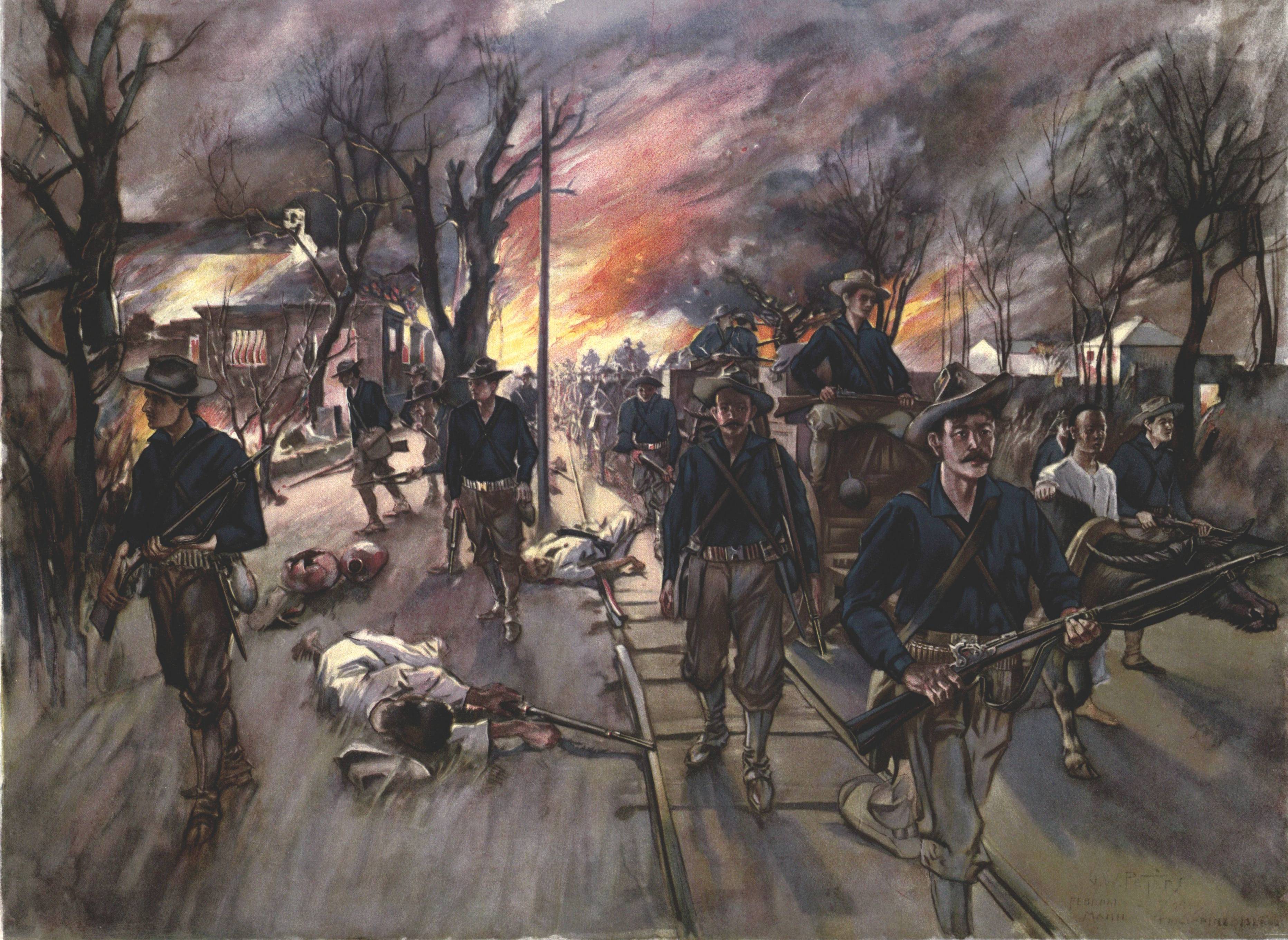|
Tandang Sora Avenue
Tandang Sora Avenue, formerly known as Banlat Road, is a major east-west thoroughfare bisecting Quezon City in Metro Manila, the Philippines. It is a two-to-six lane highway and municipal road that runs for from its eastern terminus at Magsaysay Avenue in Pansol and U.P. Campus in Diliman to its western terminus at Quirino Highway in Baesa and Talipapa in Novaliches, crossing Barangays Culiat, New Era, Pasong Tamo, Tandang Sora, and Sangandaan. The avenue's segment east of Commonwealth Avenue is a national secondary road with the route designation N129; it also forms part of the Circumferential Road 5 (C-5) network of the Metro Manila arterial road system. Its western segment in Tandang Sora and Culiat west of Commonwealth Avenue is a narrow municipal road classified as a national tertiary road. Tandang Sora Avenue was named after its location in the barangay of Tandang Sora. The barrio, in turn, was renamed from Talipapa in 1952 in honor of Filipina patriot Melchora Aqui ... [...More Info...] [...Related Items...] OR: [Wikipedia] [Google] [Baidu] |
Commonwealth Avenue, Quezon City
Commonwealth Avenue, formerly known as Don Mariano Marcos Avenue, is a highway located in Quezon City, Philippines, which spans from six to eighteen lanes and is the widest in the Philippines. It is one of the major roads in Metro Manila and is designated as part of Radial Road 7 (R-7) of the older Manila arterial road system and National Route 170 (N170) of the Philippine highway network. Commonwealth Avenue starts from Elliptical Road, which circumscribes the Quezon Memorial Circle, and it passes through the areas of Philcoa, Tandang Sora, Balara, Batasan Hills, Fairview, and ends at Quirino Highway in the Novaliches area. The avenue, being located on Quezon City, which is listed as one of several cities in Metro Manila with high incidence of road accidents, has a high rate of accidents, especially related to overspeeding, and has gained the nickname "Killer Highway". A speed limit is being enforced to reduce the high rate of accidents on the avenue. Route description Comm ... [...More Info...] [...Related Items...] OR: [Wikipedia] [Google] [Baidu] |
Barangay
A barangay (; abbreviated as Brgy. or Bgy.), historically referred to as barrio (abbreviated as Bo.), is the smallest administrative division in the Philippines and is the native Filipino term for a village, district, or ward. In metropolitan areas, the term often refers to an inner city neighborhood, a suburb, or a suburban neighborhood or even a borough. The word ''barangay'' originated from '' balangay'', a type of boat used by a group of Austronesian peoples when they migrated to the Philippines. Municipalities and cities in the Philippines are politically subdivided into barangays, with the exception of the municipalities of Adams in Ilocos Norte and Kalayaan in Palawan, with each containing a single barangay. Barangays are sometimes informally subdivided into smaller areas called ''purok'' ( en, " zone"), or barangay zones consisting of a cluster of houses for organizational purposes, and '' sitios'', which are territorial enclaves—usually rural—far from th ... [...More Info...] [...Related Items...] OR: [Wikipedia] [Google] [Baidu] |
Caloocan
Caloocan, officially the City of Caloocan ( fil, Lungsod ng Caloocan; ), is a 1st class Cities of the Philippines#Legal classification, highly urbanized city in Metropolitan Manila, Philippines. According to the 2020 census, it has a population of 1,661,584 people making it the List of cities in the Philippines, fourth-most populous city in the Philippines. Caloocan is divided into two geographical locations with a total combined area of . It was formerly part of the Rizal, Province of Rizal of the Philippines' Southern Tagalog, Southern Luzon Region. It comprises what is known as the Administrative divisions of Metro Manila#Districts, CAMANAVA area along with cities Malabon, Navotas and Valenzuela, Metro Manila, Valenzuela. South Caloocan is bordered by Manila, Quezon City, Malabon, Navotas and Valenzuela. Presence of commercial and industrial activities combined with residential areas make it a highly urbanized central business district and a major urban center in the Norther ... [...More Info...] [...Related Items...] OR: [Wikipedia] [Google] [Baidu] |
Rappler
Rappler (portmanteau of the words "rap" and "ripple") is a Filipino online news website based in Pasig, Metro Manila, the Philippines. It was founded by 2021 Nobel Peace Prize laureate Maria Ressa along with a group of fellow Filipino journalists as well as technopreneurs. It started as a Facebook page named MovePH in August 2011 and evolved into a website on January 1, 2012. In 2018, agencies under the Philippine government initiated legal proceedings against Rappler. Rappler and its staff alleged it was being targeted for its revelations of corruption by government and elected officials, the usage of bots and trolls favoring Rodrigo Duterte's administration, and documenting the Philippine drug war. In October 2021, Rappler co-founder Ressa, alongside Russian journalist Dmitry Muratov, was awarded the Nobel Peace Prize for safeguarding freedom of expression in their homelands. History With the idea of professional journalists using social media and crowd sourcing for news distr ... [...More Info...] [...Related Items...] OR: [Wikipedia] [Google] [Baidu] |
Manila Metro Rail Transit System Line 7
The Metro Rail Transit Line 7, also known as MRT Line 7 or MRT-7, is a rapid transit line under construction in the Philippines. When completed, the line will be long, with 14 stations, and the first line to have a third rail electrification. The line runs in a northeast–southwest direction, beginning at San Jose del Monte, Bulacan up to the North Triangle Common Station in North Avenue, Quezon City. First planned in 2001 and approved in 2004, the 25-year concession agreement was signed in 2008 between the Philippine government and the project's original proponent, Universal LRT Corporation. However, construction has been repeatedly delayed due to right-of-way issues. The project was re-approved in 2013, while funding for the project was obtained in 2016. Construction on the line began the following year and is slated to open by December 2022. The project will cost an estimated ₱62.7 billion (US$1.54 billion), with additional plans are laid for capacity expansion in orde ... [...More Info...] [...Related Items...] OR: [Wikipedia] [Google] [Baidu] |
Tandang Sora Station
Tandang Sora station is an under-construction Manila Metro Rail Transit (MRT) station situated on Line 7 located along Commonwealth Avenue in Matandang Balara, Quezon City. The Tandang Sora Flyover was demolished in March 2019 to give way for the construction of the MRT-7 station. Nearest landmarks include the Iglesia ni Cristo Central Temple, New Era University and Net 25 TV studios. The station is named after Melchora Aquino also known as Tandang Sora, one of the key personalities in the Philippine Revolution. This station should not be confused with the future Tandang Sora Station of the Metro Manila Subway Line 9, to be constructed at the corner of Tandang Sora Avenue and Mindanao Avenue Mindanao Avenue ( fil, Abenida Mindanao) is an eight-to-ten lane divided avenue connecting EDSA and NLEX and is a part of Circumferential Road 5 (C-5) in Metro Manila, Philippines. It is one of the three parallel roads that connects Tanda ..., also in Quezon City. , the pr ... [...More Info...] [...Related Items...] OR: [Wikipedia] [Google] [Baidu] |
The Philippine Star
''The Philippine Star'' (self-styled ''The Philippine STAR'') is an English-language newspaper in the Philippines and the flagship brand of the Philstar Media Group. First published on July 28, 1986, by veteran journalists Betty Go-Belmonte, Max Soliven and Art Borjal, it is one of several Philippine newspapers founded after the 1986 People Power Revolution. The newspaper is owned and published by Philstar Daily Inc., which also publishes the monthly magazine ''People Asia'' and the Sunday magazines ''Starweek'' and ''Let's Eat''. As part of the Philstar Media Group, its sister publications include business newspaper '' BusinessWorld''; Cebu-based, English-language broadsheet ''The Freeman''; Filipino-language tabloids ''Pilipino Star Ngayon'' and ''Pang-Masa''; Cebuano-language tabloid ''Banat'', online news portals Interaksyon (formerly with News5), LatestChika.com, Philstar Life and Wheels.ph, and TV/digital production unit Philstar TV. In March 2014, the newspaper wa ... [...More Info...] [...Related Items...] OR: [Wikipedia] [Google] [Baidu] |
Melchora Aquino
Melchora Aquino de Ramos (January 6, 1812 – February 19, 1919) was a Filipino revolutionary. She became known as "Tandang Sora" because of her age during the Philippine Revolution. She was known as the "Grand Woman of the Revolution" and the "Mother of Balintawak" for her contributions. Early life and marriage Known as the "Mother of Revolution," Tandang Sora was born on January 6, 1812 in Barrio Banlat, Caloocan (the present-day Barangay Tandang Sora, Quezon City). Tandang Sora, daughter of a peasant couple, Juan and Valentina Aquino, never attended school. However, she was apparently literate at an early age and talented as a singer and performed at local events as well as at Mass for her Church. She was also often chosen for the role of ''Reyna Elena'' during the "Santacruzan", a processional pageant commemorating Empress Helen's finding of the Cross of Christ, celebrated in the Philippines in May. Later in life, she married Fulgencio Ramos, a ''cabeza de barrio'' ... [...More Info...] [...Related Items...] OR: [Wikipedia] [Google] [Baidu] |
List Of Roads In Metro Manila
This list of roads in Metro Manila summarizes the major thoroughfares and the numbering system currently being implemented in Metro Manila, the Philippines. Metro Manila's arterial road network comprises six circumferential roads and ten radial roads connecting the cities of Caloocan, Las Piñas, Makati, Malabon, Mandaluyong, Manila, Marikina, Muntinlupa, Navotas, Parañaque, Pasay, Pasig, Quezon City, San Juan, Taguig, and Valenzuela, and the municipality of Pateros. Route classification This list only covers roads that are listed as National Primary, National Secondary, or National Tertiary Roads on the Department of Public Works and Highways's Infrastructure Atlas, as well as the previous Circumferential and Radial Road system prior to 2014. These road classifications are defined as follows: * National Primary Roads – Contiguous road sections extending that connect major cities. Primary roads make up the main trunk line or backbone of the National Road System. * Natio ... [...More Info...] [...Related Items...] OR: [Wikipedia] [Google] [Baidu] |
N129 Highway (Philippines)
National Route 129 (N129) or simply Route 129 is a secondary national route in Metro Manila that forms part of the Philippine highway network. Entirely located within Quezon City, it comprises Congressional Avenue, Congressional Avenue Extension, portion of Luzon Avenue, portion of Tandang Sora Avenue, and portion of Katipunan Avenue Katipunan Avenue ( fil, Abenida Katipunan) is a major avenue in Quezon City, Metro Manila, Philippines. It runs in a north–south direction from the University of the Philippines Diliman, intersecting with Tandang Sora Avenue at its northernmos ...; most of them are part of C-5 with the exception of EDSA–Mindanao Avenue segment. References Streets in Quezon City {{Philippines-road-stub ... [...More Info...] [...Related Items...] OR: [Wikipedia] [Google] [Baidu] |
New Era, Quezon City
New Era is a barangay in Quezon City, Metro Manila, Philippines. It is noted for its dominant Iglesia ni Cristo population. Geography The Tandang Sora Avenue is situated on the northern and eastern boundary of New Era. The barangay is also bounded on the southeast by Commonwealth Avenue and on the south by Central Avenue. Sitio Mabilog is situated on its southwest boundary while lots no. 689, 680, 678, and 689 of the Piedad Estate and San Antonio Subdivision delineates New Era's eastern boundaries. History New Era was created by Presidential Decree No. 1760 which was issued by then-President Ferdinand Marcos on January 2, 1981. The barangay was carved from a portion of barangay Culiat. The Central Temple and the New Era University of the Iglesia ni Cristo which are situated within the barangay was inaugurated in 1984. Demographics About 95 percent of the barangay's population consists of members of the Iglesia ni Cristo. The Christian church host some of its significant fa ... [...More Info...] [...Related Items...] OR: [Wikipedia] [Google] [Baidu] |





